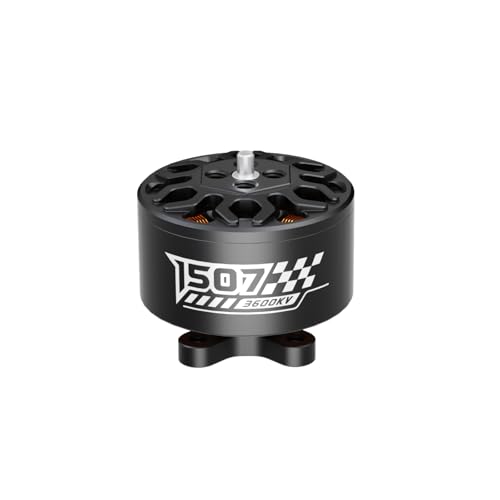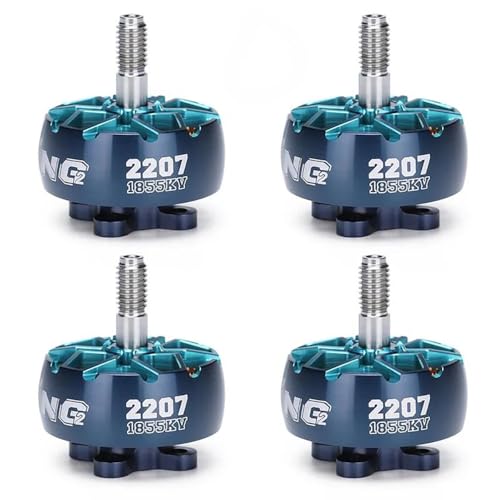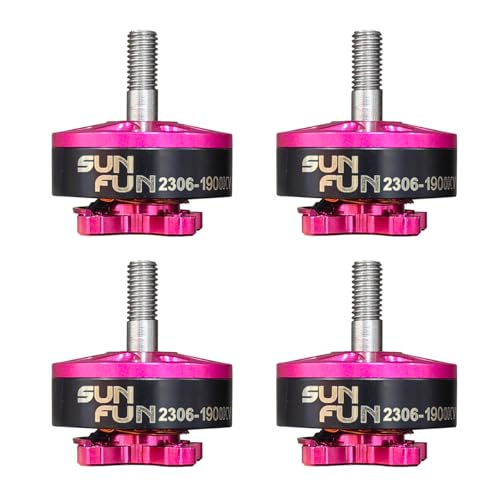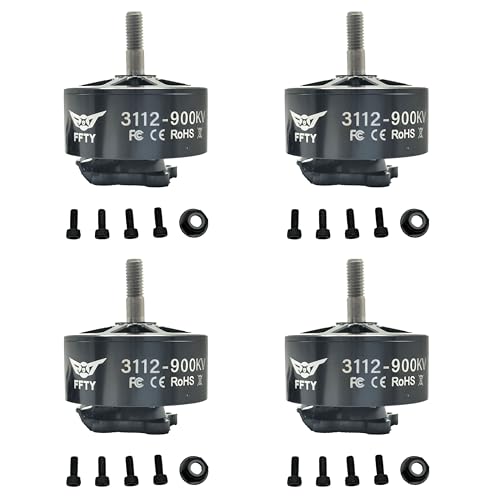Choosing the right motor is arguably one of the most critical decisions you’ll make for your FPV drone build. It’s not just about raw power; it’s about efficiency, durability, and matching your flying style, whether you’re into cinematic smooth flights, aggressive freestyle, or lightning-fast racing. A great motor transforms your drone from a collection of parts into a soaring beast.
But with so many options out there, how do you pick the best motor for FPV drone applications that suits your needs? Don’t sweat it! We’ve done the heavy lifting and compiled a list of 10 top-tier FPV drone motors that stand out for their performance, reliability, and value. We’ll break down their features, pros, cons, and what users are saying, so you can make an informed choice. Let’s dive in!
Why Your FPV Motor Matters
Think of your FPV drone motor as its heart. It dictates thrust, flight time, responsiveness, and overall flight characteristics. The right motor, paired with the correct battery and propellers, creates a harmonious system that delivers optimal flight performance. Factors like KV rating, motor size (e.g., 2207, 0802SE), and battery compatibility (like 4S or 6S LiPo) are crucial in determining how your drone will handle in the air. Getting this part right is key to enjoying your FPV experience.
Our Top Picks for the Best Motor for FPV Drone
Let’s explore some of the best brushless motors currently available for FPV drones, from tiny whoops to aggressive 5-inch freestyle setups.
1. Axisflying FPV Drone Brushless Motor – 2207 1960KV 6S

This Axisflying AE series motor is a true workhorse, designed for pilots who demand exceptional performance and reliability without breaking the bank. Its unique Bearing Shield Technology (BST) sets it apart, offering enhanced durability against environmental elements.
- Key Features
- Premium performance and excellent price-performance balance
- Bearing Shield Technology (BST) for dustproof and waterproof bearing protection
- High compatibility with a wide range of drone frames and ESCs
- Generates over 1.6KG thrust, drawing max 38A current
- Compact and lightweight design (Φ27.2*33.3MM, 32.1g with cables)
- Pros
- Exceptional durability thanks to BST
- High thrust makes it ideal for aggressive freestyle
- Versatile compatibility with various setups
- Lightweight, aiding overall drone agility
- Cons
- Max current draw (38A) might require a robust ESC
- 1960KV might be a bit high for some cinematic setups
- User Impressions
Pilots rave about the smooth power delivery and the noticeable resilience against dirt and moisture. Many highlight its fantastic balance of power and efficiency for a 6S setup, making it a favorite for those who fly in varied conditions. - Call-to-Action: See it on Amazon here
2. Readytosky RS2205 2300KV Brushless Motor CW/CCW 3-4S RC

The Readytosky RS2205 is a popular choice for budget-conscious builders looking for solid performance on 3S or 4S LiPo batteries. It’s ready to go with pre-soldered banana plugs, saving you time and hassle on your build.
- Key Features
- Supports 3-4S LiPo batteries for versatile power options
- Comes with pre-soldered 2mm banana plugs
- Enhanced anti-off U-ring for increased safety and stability
- Active cooling fins to significantly reduce motor temperatures
- Durable stainless steel motor shaft and CNC machined aluminum case
- Pros
- Great value for its performance class
- Easy installation with pre-soldered plugs
- Excellent cooling design helps prolong motor life
- Robust build quality for its price point
- Cons
- 2300KV might be less efficient for longer flight times compared to lower KV options
- Might not offer the same peak thrust as premium 6S motors
- User Impressions
Users often praise this motor as a reliable and affordable entry into FPV racing. The pre-soldered plugs are a massive convenience, and many pilots report good durability even after hard crashes. It’s a solid choice for 210-280mm frames. - Call-to-Action: See it on Amazon here
3. Axisflying FPV Drone Brushless Motor – 2207 1850KV 6S

Another stellar offering from Axisflying, this 1850KV version of the AE2207 motor is optimized for 6S setups, providing a perfect blend of power and efficiency, especially for pilots favoring controlled freestyle or longer flights.
- Key Features
- Premium performance with an ideal price-performance ratio
- Bearing Shield Technology (BST) for dustproof and waterproof bearing protection
- High compatibility with a wide range of drone frames and ESCs
- Generates over 1.6KG thrust, drawing max 38A current
- Compact and lightweight design (Φ27.2*33.3MM, 32.1g with cables)
- Pros
- Excellent balance of power and efficiency for 6S
- Enhanced durability with BST
- Versatile for various drone types, from freestyle to light cinematic
- Maintains a lightweight profile for agile drones
- Cons
- Similar max current draw to its 1960KV sibling, requiring capable ESCs
- Price point might be higher than budget alternatives
- User Impressions
Pilots appreciate the refined power delivery and the ability to achieve good flight times on 6S. The BST feature is consistently highlighted as a major benefit, making these motors a robust choice for any flying environment. - Call-to-Action: See it on Amazon here
4. BETAFPV 4pcs 0802SE 23000KV Brushless Motor 1S Lightweight

For the tiny whoop enthusiasts, the BETAFPV 0802SE 23000KV motor is a game-changer. These lightweight motors provide an aggressive thrust for 1S micro drones, perfect for indoor FPV racing and acrobatics where every gram counts.
- Key Features
- Higher RPM and faster response time for stronger thrust compared to 19500KV
- Lightweight at only 1.8g/pc, ideal for 65mm brushless whoop drones
- Perfect dynamic balance for flexibility and longer flying time
- Compatible with 31mm, 35mm, and 40mm propellers with a 1.0mm shaft hole
- New silver appearance and brass bushings bearing
- Pros
- Significantly improves speed and responsiveness of whoop drones
- Ultra-lightweight for maximizing flight duration and agility
- Broad propeller compatibility adds versatility
- Easy to repair due to soldered lead wires to PCB
- Cons
- Exclusively for 1S setups, limiting power for larger drones
- High KV can be less efficient for cruising, favoring aggressive flight
- User Impressions
Whoop pilots absolutely love the punch these motors deliver. They transform small drones into zippy, responsive machines, allowing for more aggressive indoor flying. The lightweight design is frequently praised, though some note the small size makes handling delicate. - Call-to-Action: See it on Amazon here
5. SpeedyBee 2306.5 1800KV Brushless Motor 6S for 5 Inch FPV

SpeedyBee brings us the 2306.5 1800KV motor, a track-tuned powerhouse designed for 5-inch FPV drones. Whether you’re into acrobatic flights or smooth cinematic captures, this motor offers a balanced and reliable performance on 6S.
- Key Features
- Track-tuned 1800KV brushless high-speed motor
- Full compatibility with 5-inch FPV drone parts
- Excels in both acrobatic flights and filming for smoother performance
- Comes in a pack of 4 for a complete drone build
- Includes M3 8mm mounting screws
- Pros
- Excellent versatility for various 5-inch drone applications
- Delivers smooth and predictable power output
- High-quality components ensure long-lasting performance
- Ideal KV for 6S setups, balancing power and efficiency
- Cons
- Might be considered slightly heavy by ultra-lightweight build enthusiasts
- 1800KV might not be “punchy” enough for hardcore racing fanatics compared to higher KV options
- User Impressions
Pilots building SpeedyBee Master5 V2 drones or similar 5-inch setups often choose these motors for their reliable and consistent performance. They’re noted for their smooth flight characteristics and durability, making them a solid choice for everyday flying. - Call-to-Action: See it on Amazon here
6. SpeedyBee 1507 3600KV Brushless Motor 4S for 3-3.6 Inch

For smaller, agile 3-3.6 inch FPV drones, the SpeedyBee 1507 3600KV motor provides exhilarating power on 4S. This motor is built for aggressive freestyle and pro racing, offering a strong magnetic structure for long-lasting dynamic balance.
- Key Features
- Track-tuned 3600KV brushless high-speed motor
- Full compatibility with 3-3.6 inch FPV drone parts
- Strong magnetic structure ensures dynamic balance and longevity
- Designed for aggressive freestyle to pro racing drone applications
- Includes various mounting screws for easy installation
- Pros
- High KV provides impressive punch and speed for smaller drones
- Robust construction for aggressive flying
- Excellent for lightweight, high-performance builds
- Long-lasting dynamic balance contributes to smooth flight
- Cons
- High KV means it’s less efficient for prolonged cruising
- Primarily designed for 4S, limiting battery voltage options
- User Impressions
Pilots building smaller toothpick or cinewhoop-style drones praise these motors for their incredible responsiveness and power-to-weight ratio. They’re often chosen for their ability to make agile, fast drones for tight spaces or quick maneuvers. - Call-to-Action: See it on Amazon here
7. XING2 2207 1855KV 3-6S / 2755KV 3-5S Brushless FPV Motor

The XING2 series motors are renowned for their incredible durability and innovative design. With a focus on impact resistance and smooth operation, these motors are a favorite among pilots who push their drones to the limits. This model offers two KV options for flexibility.
- Key Features
- Ultra-strong 5mm titanium alloy axle
- Impact-resistant 7075 aluminum hood
- Long-life smooth 9x9x4 NSK bearings
- Central Grooved N52H Curved Arc Magnets for improved performance
- XING O-ring bearing gap protection and motor cable protector
- Dynamically balanced
- Pros
- Exceptionally durable, built to withstand crashes
- High-quality NSK bearings ensure smooth, long-lasting operation
- Excellent power delivery due to N52H magnets
- Comprehensive protection features for longevity
- Cons
- Premium components might come with a higher price tag
- The “central grooved” magnet design can sometimes collect debris more easily
- User Impressions
The XING2 motors are practically legendary for their toughness. Pilots frequently report how these motors survive impacts that would cripple others. Their smooth power and precise control are highly valued, making them a top contender for the best motor for FPV drone pilots seeking reliability. - Call-to-Action: See it on Amazon here
8. DYS 4PCS SUNFUN 2306 1900KV 6S Brushless Motor for FPV

The DYS SUNFUN 2306 motors are an upgraded series known for their smooth, reliable, and powerful performance. These 12N 14P high-torque motors are well-suited for 5-inch propellers and 6S LiPo batteries, delivering incredible power in a lightweight package.
- Key Features
- Upgraded SUNFUN2306 design with 12N 14P high torque
- Supports 2-6S LiPo batteries, offering broad compatibility
- 1900KV, compatible with M3*16 motor mounts and 5-inch propellers
- Provides incredible power and thrust in a lightweight design
- Dynamically balanced rotors with high-purity copper windings
- Pros
- Versatile 2-6S battery compatibility
- High torque provides excellent responsiveness
- Lightweight design contributes to agile flight
- Good insulation and heat resistance for durability
- Cons
- 1900KV on 6S might be slightly less efficient for pure endurance flying
- Some users might prefer more premium bearing options
- User Impressions
Many FPV pilots appreciate these DYS motors for their consistent performance and robust build quality. They are often chosen for freestyle builds where a blend of power and efficiency on 6S is desired. The 5-inch propeller compatibility makes them a standard go-to. - Call-to-Action: See it on Amazon here
9. DYS 4PCS SUNFUN 2207 1750KV 6S Drone Motor for FPV

Similar to its 2306 sibling, the DYS SUNFUN 2207 1750KV motor is another excellent option for 6S FPV drones, especially those looking for a slightly lower KV for efficiency or more controlled power. This motor boasts a high-strength 5mm steel hollow shaft and single-strand winding for optimized performance.
- Key Features
- Upgraded SUNFUN2207 design with 12N 14P high torque
- Supports 2-6S LiPo batteries
- Features a high-strength 5MM steel hollow shaft and M3 shaft screws
- Single strand winding for enhanced performance
- Dynamically balanced rotors with high-purity copper windings
- Pros
- Lower 1750KV offers better efficiency for longer flight times on 6S
- Robust 5mm hollow shaft for durability
- High torque provides smooth and reliable power
- Wide 2-6S battery compatibility
- Cons
- May not have the “punch” of higher KV motors for aggressive racing
- Single strand winding, while efficient, can be more susceptible to damage in extreme crashes compared to multi-strand.
- User Impressions
This DYS motor is often chosen by pilots seeking a more balanced approach to 6S flying, valuing endurance and smoother control. Users consistently highlight its reliability and consistent power output, making it a strong contender for the best motor for FPV drone builds focused on freestyle or cinematic work. - Call-to-Action: See it on Amazon here
10. 4 Pcs 3112 900KV Brushless Motor for Drone – High-Power

Stepping up in size and power, these 3112 900KV brushless motors are designed for larger FPV drones, quadcopters, and hexacopters, optimized for 8-9 inch propellers. They deliver substantial thrust and efficiency for bigger rigs or long-range setups.
- Key Features
- High-performance 900KV brushless motor with up to 1545W max power and 4050g thrust
- Durable 12N/14P stator design with a strong 5mm shaft and high-temp silicone wires
- Optimized for 8-9 inch propellers for balanced thrust and stability
- Low 0.058Ω internal resistance for optimized cooling and efficient power
- Standard 4-M3×7 mounting holes for secure and easy installation
- Pros
- Massive power and thrust suitable for larger, heavier drones
- Excellent efficiency for longer flight times due to lower KV and low internal resistance
- Robust build quality for demanding applications
- Optimized cooling ensures stable performance during extended flights
- Cons
- Not suitable for smaller, agile 5-inch or micro FPV drones
- Requires larger propellers and a heavier frame, increasing overall build cost
- User Impressions
Pilots building long-range FPV platforms or heavy-lift drones absolutely love these motors. They provide the necessary grunt and stability for carrying payloads or flying for extended periods. The build quality and efficiency are frequently praised. - Call-to-Action: See it on Amazon here
Conclusion
Choosing the best motor for FPV drone is a personal journey, heavily influenced by your flying style, drone size, and budget. From the tiny but mighty BETAFPV 0802SE for whoops to the robust Axisflying AE series for aggressive freestyle, and the powerhouse 3112 for larger cinematic rigs, there’s a perfect motor out there for every pilot.
Consider your desired KV rating, battery compatibility, and motor size carefully. Remember that a balanced system — matching your motors to your frame, ESCs, and propellers — will always yield the best flight experience. Happy flying!
FPV Drone Motor FAQ
Q1: What does KV mean for FPV drone motors?
A1: KV stands for Kilovolts (often seen as RPM per Volt). It represents how many revolutions per minute (RPM) a motor will attempt to make per volt applied to it, with no load. A higher KV motor spins faster at a given voltage but typically produces less torque, while a lower KV motor spins slower but with more torque.
Q2: How do I choose the right motor size (e.g., 2207, 0802SE) for my FPV drone?
A2: The motor size (e.g., 2207) refers to the stator dimensions: 22mm diameter and 7mm height.
* Smaller motors (e.g., 0802, 1103): For micro drones and tiny whoops (65-100mm frames)
* Medium motors (e.g., 1404, 1507): For toothpick or 3-4 inch drones, balancing power and weight.
* Standard motors (e.g., 2207, 2306): The most common for 5-inch freestyle and racing drones, offering a great balance of power and efficiency.
* Larger motors (e.g., 3112): For 7-inch, 8-inch, or larger long-range and cinematic drones that need significant thrust for heavier payloads or bigger propellers.
Q3: What’s the difference between 4S and 6S motors?
A3: 4S and 6S refer to the number of cells in a LiPo battery (4 cells or 6 cells). A 6S battery provides higher voltage than a 4S (roughly 22.2V vs 14.8V nominal).
* 4S motors: Often higher KV (e.g., 2300-2600KV) to achieve desired RPMs with lower voltage. Good for responsiveness and lighter builds.
* 6S motors: Typically lower KV (e.g., 1700-1950KV) as they use higher voltage. They offer better efficiency, smoother power delivery, and generally more ‘headroom’ for power, making them popular for freestyle and long-range builds.
Q4: Are brushless motors always better than brushed motors for FPV drones?
A4: For almost all performance FPV drones, brushless motors are significantly better. They are more efficient, more powerful, more durable, and require less maintenance than brushed motors. Brushed motors are typically only found in very small, toy-grade drones or extremely budget-friendly micro-quads.
Q5: How do propellers affect motor choice?
A5: Propellers are crucial! Larger propellers generate more thrust but require more torque from the motor and generally work better with lower KV motors. Smaller, higher-pitch propellers typically pair well with higher KV motors for snappy response. Always check motor specifications for recommended propeller sizes. An unbalanced prop can also lead to vibrations and reduce motor efficiency.
Q6: What are some common causes of FPV motors burning out?
A6: Common causes include:
* Prop strikes: Hard hits can bend shafts, damage bearings, or cause magnets to rub, leading to overheating.
* Over-propping: Using propellers that are too large or have too aggressive a pitch for the motor can cause it to draw excessive current and overheat.
* Incorrect voltage: Using a battery with too high a voltage (e.g., 6S on a 4S-only motor) will quickly destroy it.
* Bearing failure: Worn or seized bearings increase friction, causing the motor to work harder and overheat.
* Dirt/debris: Ingress of sand, dust, or small particles can damage bearings or get between the stator and magnets.
* ESC issues: A faulty ESC can send incorrect signals or voltage, damaging the motor.
Q7: Should I get CW or CCW motors for my FPV drone?
A7: For modern FPV brushless motors, the distinction between CW (clockwise) and CCW (counter-clockwise) is largely obsolete. Most FPV motors can spin in either direction, with their rotation controlled by the Electronic Speed Controller (ESC) through software settings (like in Betaflight). You simply mount them and configure their spin direction in your flight controller.



